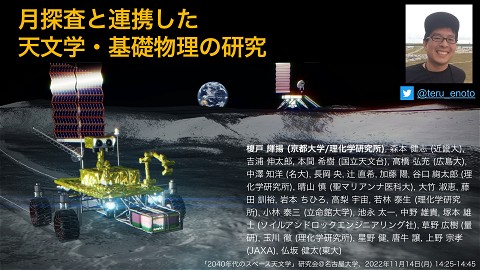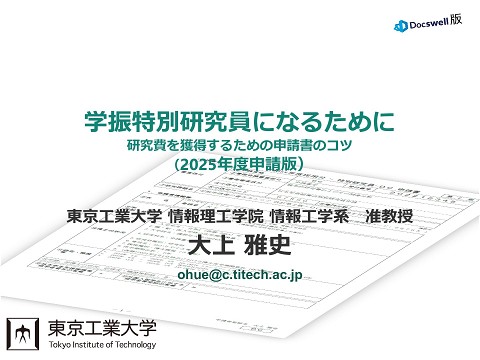「中性子星の観測的研究の進展」@基研研究会 「熱場の量子論とその応用」
4K Views
September 22, 22
スライド概要
基研研究会 「熱場の量子論とその応用」
2022年9月22日@京都大学・基礎物理学研究所での招待講演
https://www.riise.hiroshima-u.ac.jp/TQFT/html2022/tqft2022.html
http://enotolab.com
関連スライド
各ページのテキスト
中性子星の観測的研究の進展 榎戸輝揚 (Teruaki Enoto) @teru_enoto (理化学研究所 / RIKEN) 2022年9月22日 9:00-10:00 基研研究会「熱場の量子論とその応用」(1時間) https://www.riise.hiroshima-u.ac.jp/TQFT/html2022/tqft2022.html
本日の話題 • 中性子星の観測的な多様性(特にマグネター) • 国際宇宙ステーションに搭載された NICER • 中性子星の質量と半径を宇宙観測で計測する • かにパルサーの巨大電波パルス(高速電波バースト) 2
中性子星 (Neutron star) Supernova Remnant Cassiopeia A 4-6 keV X-rays (white) Fe (red) Si, Mg (green) Ti (blue) 中性子星: 半径 R~12 km, 質量 M~1.4 Msun 大質量星の重力崩壊で誕生する ©NASA/JPL-Caltech/CXC/SAO, Grefenstette et al., 2014, 榎戸輝揚, 物理学会・領域2シンポジウム「高強度パワーレーザー及びX線自由電子レーザーを活用したプラズマ科学の展望」2015年9月18日 Nature
t started 50 years ago as a ‘smudge’ on paper has flourished into a fundamental field of astrophysics replete unexpected applications and exciting discoveries. To celebrate the discovery of pulsars, we look at the past, ent and future of pulsar astrophysics. パルサーの発見 (1967年) は 55年前 PERSPECTIVE 論文の出版は翌年、Hewish, Bell, et al., Nature (1968) Taylor and Russell Hulse in 1975 of a pulsar y years ago this month, Jocelyn Bell in a binary system with another neutron urnell (pictured) had already seen star. The orbit of the pulsar was observed e recurring blips on her hundredsto shrink in the exact way that Einstein’s tres-long chart paper that was being general theory of relativity predicted if the ed out by the newly minted 4-acresystem was emitting gravitational waves adio telescope at Cambridge, UK. (and brought in another Nobel Prize her with her PhD advisor, Antony for the pulsar field). Today, we are not h, they were hard at work trying to only detecting pulsars and neutron stars stand their nature and the source that have generated them. The study of what from space (see the Mission Control by Keith Gendreau and Zaven Arzoumanian), w know as pulsars has developed into but a network of pulsars is poised to ant field of research that touches upon become the largest gravitational-wave t all areas of astrophysics and beyond: detector at our disposal (see the Article tellar astronomy, to the physics of by Chiara Mingarelli and collaborators nsed matter, to gravitational waves and and the Comment by Andrea Lommen). ry fabric of our Universe. In this Gravitational-wave detection aside, pulsars ssue we bring together some of the パルサー発見の電波望遠鏡 are now being used to probe the most xciting pulsar science and reflect on Four-acre array Astronomy Observatory, Cambridge, fundamental properties of spacetime ure directions of the field.at the Mullard Radio UK, of Credit: Graham Burnell, 2017, Nature the Comment by Kuoastronomy) Liu and Ralph e discovery pulsars requiredWoan the (J. B.(see 4 of a self-professed imposterEatough) and of condensed matter. Some veness have very little information on the sities and consequently there is a the interior with relatively few ob know of one or two heavy pulsar solar masses, which implies some know that there must be superfluid rotation is likely to be quantized w Sudden unpinning of these vortice word that has now entered common is a sudden increase in rotation spe nential or several-exponential) retu Pulsars can be used as tools for along their lines of sight. Our know Jocelyn Bell Burnell さん electrons in the galaxy is now much Credit: Daily Herald Archive 1 this medium is still being revealed SSPL / Getty Images Pulsars make remarkably stable
天文月報 1969年7月 の鶴田幸子先生の記事 5
中性子星の研究史は、ほぼ1世紀 •1932年 チャドウィックが中性子を発見 (1935年にノーベル物理学賞) •1934年 バーデとツビッキーが、超新星爆発の後に、中性子からなる天体が残る可能性を指摘 •1939年 オッペンハイマーとヴォルコフが、中性子星の質量と半径を理論的に計算 •1967年 ベルとヒューイッシュが、パルサー PSR B1919+21を発見 (1974年にノーベル物理学賞) •1968年 かに星雲の中心に、かにパルサーが発見される •1974年 ハルスとテイラーが連星パルサーで重力波の間接的な証明(1993年にノーベル物理学賞) •1979年 大マゼラン雲にあるマグネター SGR 052666 から軟ガンマ線での巨大フレアが検出 •1982年 バッカーらが、最初のミリ秒パルサー PSR B1937+21 を発見 •1992年 ミリ秒パルサー PSR B1257+12 に、複数の惑星が発見 •2007年 ロリマーらが、パークス電波望遠鏡のアーカイブデータに最初の高速電波バーストを発見 •2017年 LIGO と Virgo が連星中性子星の合体にともなう重力波イベント GW170817 を検出 •2020年 銀河系内のマグネター SGR 1935+2154 から FRB とX線バーストが同時に観測 6 発見より30年以上も前から、中性子星の内部構造や質量と半径の理論計算 → 宇宙観測と原子核研究のクロスオーバーの意義を何よりも表す歴史
宇宙科学に関係するノーベル物理学賞 7 •1936年 •1967年 •1974年 •1974年 •1978年 •1983年 •1983年 •1993年 •2002年 •2002年 •2006年 •2011年 •2015年 •2017年 •2019年 •2019年 •2020年 ヘス, 宇宙線の発見 ベーテ, 原子核反応理論への貢献、特に星の内部におけるエネルギー生成に関する発見 ライル, 電波天文学における先駆的研究(観測および発明、特に開口合成技術に関して) ヒューイッシュ, 電波天文学における先駆的研究(パルサーの発見に果たした決定的な役割) ペンジアスとウィルソン, 宇宙マイクロ波背景放射の発見 チャンドラセカール, 星の構造および進化にとって重要な物理的過程に関する理論的研究 ファウラー, 宇宙の化学元素の生成で重要な原子核反応に関する理論的および実験的研究 ハルスとテイラー, 重力研究の新しい可能性を開いた新型連星パルサーの発見 ジャコーニ, 宇宙X線源の発見を導いた天体物理学への先駆的貢献 デイビスと小柴, 天体物理学への先駆的貢献、特に宇宙ニュートリノの検出 マザーとスムート, 宇宙マイクロ波背景放射が黒体放射およびその非等方性の発見 パールマッター, シュミット, リース, 遠方の超新星の観測を通した宇宙の加速膨張の発見 梶田とマクドナルド, ニュートリノが質量を持つことを示すニュートリノ振動の発見 ワイス, バリッシュ, ソーン, LIGO検出器および重力波の観測への決定的な貢献 マイヨールとケロー, 太陽型恒星を周回する太陽系外惑星の発見 ピーブルス, 物理宇宙論における理論的発見 何らかの形で特に ゲンツェルとゲズ, 銀河系の中心にある超大質量コンパクト天体の発見 中性子星に関係する研究
F パルサー発見から半世紀 ifty years ago this month, Jocelyn Bell Burnell (pictured) had already seen the recurring blips on her hundredsof-metres-long chart paper that was being churned out by the newly minted 4-acrearray radio telescope at Cambridge, UK. Together with her PhD advisor, Antony Hewish, they were hard at work trying to understand their nature and the source that could have generated them. The study of what we now know as pulsars has developed into a vibrant field of research that touches upon almost all areas of astrophysics and beyond: from stellar astronomy, to the physics of condensed matter, to gravitational waves and the very fabric of our Universe. In this focus issue we bring together some of the most exciting pulsar science and reflect on the future directions of the field. The discovery of pulsars required the attentiveness of a self-professed impostersyndrome-suffering PhD student (whose contribution was disappointingly snubbed when the Nobel Prize committee came knocking), the prowess of a novel telescope probing new parts of parameter space and of course the collective thinking of our community to figure out what these blips were (see the Perspective by Jocelyn Bell Burnell). Pulsars are the end products of massive stellar evolution, compact stars made primarily out of neutrons, often spinning at dizzying speeds (up to ~0.24 Taylor and Russell Hulse in 1975 of a pulsar in a binary system with another neutron star. The orbit of the pulsar was observed to shrink in the exact way that Einstein’s general theory of relativity predicted if the system was emitting gravitational waves (and brought in another Nobel Prize for the pulsar field). Today, we are not only detecting pulsars and neutron stars from space (see the Mission Control by Keith Gendreau and Zaven Arzoumanian), but a network of pulsars is poised to become the largest gravitational-wave detector at our disposal (see the Article by Chiara Mingarelli and collaborators and the Comment by Andrea Lommen). Gravitational-wave detection aside, pulsars CP1919 are now being used to probe the most fundamental properties of spacetime (PSR J1921+2153) (see the Comment by KuosLiu and Ralph P=1.33 Eatough) and of condensed matter. Some of these topics were discussed recently at the IAU Symposium 337 on the occasion of the pulsar discovery (summarized in the Meeting Report by Nanda Rea) that took place on the grounds of the Jodrell Bank Observatory — itself celebrating 60 years of discoveries in pulsar research and beyond (see the Perspective by Andrew Lyne and Ian Morison). The discovery of pulsars was not only fortuitous but more importantly it was serendipitous. When the Cambridge 1967年11月28日 Credit: Daily Herald Archive SSPL / Getty Images Credit: Daily Herald Archive / SSPL / Getty Images probing a new niche of the phase space, serendipitous discoveries are bound to happen, as long as we have vigilance and an open mind to identify them as such — attributes Bell Burnell and Hewish did have. Nowadays, however, not many
1996ApJ...468..779M パルサー発見から半世紀 1968年 若い (+1年) Chandra, Hubble, and Spitzer image k 1 0. かに星雲 かにパル yr 10 P=0.033 s 低周波電波 r y k Crab Pulsar (PSR B0531+21) P = 33 ms Pdot = 4.2x10-13 s/s 1 r y M CP1919 老齢 回転駆動型パルサーの世界 赤外線 Spin-down Lsd ➡ radiation 可視光 τch = P/(2Pdot) = 1200 kyr 歴史記録1054AD➡963 yr X線 軟ガンマ線 David A. Moffett et al., ApJ 468, 779-783 (1996)
パルサー発見から半世紀 Count (0.25 s)-1 1979年 軟ガンマ線リピーター登場 Soft GammaSGR Repeater (SGR) 1900+14 SGR 0526-66 (+12年) 27 Aug. 1998 歴史上3例の 巨大フレア SGR 0526-66 (79’) SGR 1806-20 (98’) SGR 1900+14 (04’) 4 Crab Pulsar 10 3 Count (0.25 s)-1 CP1919 c.f., 超新星爆発 (重力崩壊型/Ia型) E~1051 erg SGR 1806-20 Spike Lx~1044-46 erg/s 10 4 10 3 27 Dec. 2004 Tail E~1044 erg 102 0 50 100 150 200 250 300 Time (s)
パルサー発見から半世紀 1 0 15 1987年 (+20年) Crab Pulsar 10 11 強磁場 G B 特異X線パルサー SGR 0526-66 Anomalous X-ray Pulsar 1 0 14 G SNR CTB 109 1E 2259+586 1 0 13 G 1 0 12 P Ṗ (AXP) G G CP1919 1E 2259+586 Sasaki et al., 2004 連星中の電波パルサー ミリ秒パルサー 弱磁場 Lx > Lsd エネルギー源は? SGR+AXP=強磁場天体?
中性子星の多様性: 進化の統一的理解へ 10-10 2500個以上のパルサー (銀河系に 105 個存在?) • 可視光 ~20 天体 • X線 ~100 天体 • ガンマ線 ~200 天体 2017年 ATNF v1.57 10-12 周期変化率 (s/s) 10-14 10-21 TE, Kisaka, Shibata, 2018 10-2 0.1 1 自転周期 (s) 10 12
中性子星の多様性: 進化の統一的理解へ 10-10 10-12 若い 強磁場 マグネター 強磁場パルサー XDINS 電波パルサー 周期変化率 (s/s) 10-14 10-21 「中性子星」研究の 醍醐味は基礎物理と 多様性が両立! CCO 連星中の電波パルサー ミリ秒パルサー 老齢 弱磁場 10-2 0.1 1 自転周期 (s) 2500個以上のパルサー (銀河系に 105 個存在?) • 可視光 ~20 天体 • X線 ~100 天体 • ガンマ線 ~200 天体 統一的理解への挑戦 (どう進化するか?) 10 13
Energy sources of neutron stars Rotation Accretion Radio Pulsar (Millisecond Pulsar) High Mass X-ray Binary Low Mass X-ray binary Thermal Magnetic Compact Central Object X-ray Dim Isolated NS Soft Gamma Repeater Anomalous X-ray Pulsar 14
Neutron stars as laboratories for extreme physics • Dense nuclear matter, strong gravity, rapid rotation, and strong magnetic field Rotation Period P ~ 1 s (~2 ms -- 5 hour) (Angular momentum) Supernova Remnant Pulsar Wind Nebula Normal Star Temperature T ~ 106 K Source of Diversity (~105 K --107 K) NS • Accretion Rate M Important for the Equation of State Magnetic Field B ~ 1012 G (~108 G --1015 G) Mass M ~1.4M⊙ (~1.0M⊙--2.0M⊙) Radius R~12 km (~8 km--14 km) 1 T = 104 G 15
Reports on Progress in Physics Rep. Prog. Phys. 82 (2019) 106901 (54pp) https://doi.org/10.1088/1361-6633/ab3def Review Observational diversity of magnetized neutron stars Teruaki Enoto1 , Shota Kisaka2,3,4 and Shinpei Shibata5 1 Department of Astronomy and The Hakubi Center for Advanced Research, Kyoto University, Kyoto 606-8302, Japan 2 Frontier Research Institute for Interdisciplinary Sciences, Tohoku University, Sendai, 980-8578, Japan 3 Astronomical Institute, Tohoku University, Sendai, 980-8578, Japan 4 Department of Physics and Mathematics, Aoyama Gakuin University, Sagamihara, 252-5258, Japan 5 Department of Physics, Yamagata University, Kojirakawa 1-4- 12, Yamagata, 990-8560 Japan E-mail: [email protected], [email protected] and [email protected] Received 8 August 2018, revised 8 May 2019 Accepted for publication 22 August 2019 Published 24 September 2019 Corresponding Editor Professor Gordon Baym https://iopscience.iop.org/article/10.1088/1361-6633/ab3def Python code to daw P-Pdot diagram https://colab.research.google.com/drive/1hrA6KDAILf1IJT9NinFYlR6X9iskG_td Abstract Young and rotation-powered neutron stars (NSs) are commonly observed as rapidly-spinning 16
本日の話題 • 中性子星の観測的な多様性(特にマグネター) • 国際宇宙ステーションに搭載された NICER • 中性子星の質量と半径を宇宙観測で計測する • かにパルサーの巨大電波パルス(高速電波バースト) 17
Neutron Star Interior Composition Explorer (NICER) Soft X-ray timing spectroscopy for neutron star structure, dynamics, and energetics as the ISS external attached payload with active pointing, launched on June 3, 2017 © NASA/GSFC, NICER Team • Energy band : 0.2-12 keV (Resolution : 140 eV @ 6 keV) • Time resolution : <100 ns RMS (absolute) • Non-imaging FOV 6 arcmin diameter • Background : < 0.5 cps • Sensitivity: 1×10-13 erg/s/cm2 (5σ, 0.5-10 keV, 10 ksec exposure for Crab-like) • Max rate: ~38,000 cps (3.5 Crab) Gendreau et al., SPIE (2012), Arzoumanian et al., (2014) 18 © NASA/GSFC, NICER Team
(c) NICER Team (PI: K. Gendreau, NASA/GSFC) • • • • • • Energy band : 0.2-12 keV (Resolution : 140 eV @ 6 keV) Time resolution : <100 ns RMS (absolute) Non-imaging FOV 6 arcmin diameter Background : < 0.5 cps Sensitivity: 1×10-13 erg/s/cm2 (5σ, 0.5-10 keV, 10 ksec exposure for Crab-like) Max rate: ~38,000 cps (3.5 Crab) Gendreau et al., SPIE (2012), Arzoumanian et al., (2014)
X線集光系 (X-Ray Concentrator optics; XRC) Single reflection, grazing-incidence nested gold-coated Al foils • 135 mm • • • 111 mm Multiple 24 shells are confocally nested to increase an effective area. (24x56=1344 foils) Grazing incidence optic of a parabolic gold surface to focus X-rays onto a detector (2 mm). Focal length = 1085 mm Total effective area > 1800 cm2 @1.5 keV NASA 検出器チームの一員として X線集光系の開発と製作に携わる 20
Sillicon Drift Detectors (SDDs) Resolution : 140 eV @ 6 keV, Time resolution : <100 ns RMS (absolute) Radiation shielding Au/Ag “traffic cone” Pb collar Pb disk
2017年6月3日 スケースX社による打ち上げ NICER を搭載したファルコン9ロケット@ケネディ宇宙センター 22 Webcast” YouTube: https://www.youtube.com/watch?v=JuZBOUMsYws SpaceX “CRS-11 Hosted
2017年6月3日 スケースX社による打ち上げ Buzz Aldrin 榎戸 K. Gendreau NICER を搭載したファルコン9ロケット@ケネディ宇宙センター SpaceX “CRS-11 Hosted 23 Webcast” YouTube: https://www.youtube.com/watch?v=JuZBOUMsYws
NICER の大有効面積の威力 • 1.5 keVでXMM-Newton 衛星の約2倍にあたる1900 cm2の有効面 積を使い、かにパルサーの巨大電波パルスに伴うX線増幅を発見 24 Enoto et al., Science, 372, 187-190 (2021) [arXiv: 2104.03492]
NICER の大有効面積の威力 • 1.5 keVでXMM-Newton 衛星の約2倍にあたる1900 cm2の有効面 積を使い、かにパルサーの巨大電波パルスに伴うX線増幅を発見 25 Enoto et al., Science, 372, 187-190 (2021) [arXiv: 2104.03492]
集光性能の威力: かにパルサーのX線パルス (Credit) NASA パルス検出の有意性 10 X線スペクトル 0 104 5 10-10 Counts s-1 keV-1 Null hypothesis probability 偽検出の確率 3 10-20 10 10 102 1 -30 かにパルサー+星雲 1.1 104 cps (0.3-10 keV) ~370 photons/cycle バックグラウンド より有意な検出 10-40 0 0.5 1 1.5 2 2.5 Exposure (s) 積分時間 (sec) • • 3 3.5 4 0.2 1.0 3.0 エネルギー (keV) 10.0 パルス信号は約 1 秒で統計的に有意な検出に到達!ひとみ SXS の約50倍の統計 パイルアップ、デッドタイム、データ転送の影響なし (スループット 3.8 104 cps) 26
MAXI-NICER 連携 OHMAN 計画 全天X線観測装置 MAXI NICER 突発天体 アラート 迅速に深く観測 浅く広く新天体を監視 MAXI で見つけた天体を NICER でフォローアップ観測。 すでにブラックホールや星のフレアで成果があがっており、 宇宙ステーション上での「国際連携」への米国の期待は大きい On-orbit Hookup of MAXI and NICER (OHMAN) 計画
本日の話題 • 中性子星の観測的な多様性(特にマグネター) • 国際宇宙ステーションに搭載された NICER • 中性子星の質量と半径を宇宙観測で計測する • かにパルサーの巨大電波パルス(高速電波バースト) 28
解 説 中性子星の質量と半径 • 以下の話題をレビューする。 • 高密度核物質の状態方程式を理解するため に、天体観測はどんな貢献できるのか? • 最新の宇宙X線による質量と半径の測定か ら、状態方程式はどう制限されたのか? • 状態方程式が制約されると、宇宙観測から どのような新しい知見を与えられるか? (榎戸, 安武「宇宙観測で見えてきた中性子星の状態方 程式」日本物理学会誌2021年10月号) 29 宇宙観測で見えてきた中性子星の状態方程式 榎戸輝揚 安武伸俊 理化学研究所榎戸極限自然現象理研白眉研究チーム 千葉工業大学情報科学部 /日本原子力研究開発機構 teruaki.enoto@riken.jp nobutoshi.yasutake@p.chibakoudai.jp 中性子星は,太陽よりも 1 桁大きな質量 は常に大きな問題となる天体までの距離測 の恒星が寿命を迎え,重力崩壊して残され 定の難しさもあり,信頼性のある測定が難 る高密度(コンパクト)天体である.半径 しかった. 10 km ほどの中性子星が太陽の 1.4 倍もの 近年の多波長観測の進展により,中性子 質量をもつため,内部は原子核の密度を超 星の観測的特徴の理解が進み,その多様性 える高密度となる.中性子星は,およそ半 は「中性子星の動物園」とよばれるように 世紀前に周期的に電波で明滅するパルサー なった.このような観測的多様性は,天体 として発見され,これまでに銀河系や近傍 の質量と半径の違いのみならず,中性子星 の銀河に 2,800 個を超える天体が見つかっ の表面磁場の強度や構造,温度分布,自転 ている.中性子星は表面から放出される光 周期などの違いによって生み出されたもの が曲がるほどの強い重力場をもち,量子電 で,質量と半径の測定を行うときには邪魔 磁力学における臨界磁場を超える強磁場の な不定性を生み出しうる.しかし,これら 物理現象が発現するなど,極限物理の実験 の特徴を注意深く理解していくことで,い 室である.そのため,天文学のみならず基 くつかの種族の天体やそこで起きる現象を 礎物理の観点からも関心がもたれている. うまく利用して,中性子星の質量と半径を 中性子星が理論的に提唱された時代から, この奇妙な星内部の高密度な核物質の状態 ――用語解説―― 中性子星の高密度状態: 高エネルギー状態である クォーク物質やハドロン物質 を表す QCD 相図(下図)にお いて,低温・高密度の領域は よくわかっていない.符号問 題のため格子 QCD による第 一原理計算が破綻することや, この領域を直接的に制限でき る原子核実験もないためであ る.特 に こ の 領 域 で は,カ ラー超伝導とよばれるエキゾ チックな物質状態が理論的に 予言されており,物性的観点 からも関心を集めている.一 方で,この領域はまさに中性 子星の内部に対応しているた め,天文観測が重要な役割を 担っている. 測定できることがわかり,複数の有効な手 法が提案されるようになってきた. 方程式の解明は,重要な未解決問題であり 国際宇宙ステーションに搭載された X 続けてきた.星の中心部は,地上の原子核 線望遠鏡 NICER(Neutron star Interior Com- 実験では到達できない密度領域にある.状 position ExploreR)は,高 い 集 光 能 力 を 活 態方程式のミクロな密度と圧力は,天体の かして複数のミリ秒パルサーを観測し, 内部構造を考えて積分すると,中性子星の gravitational light-bending を用いた中性子星 質量と半径のマクロな物理量に対応する. の質量と半径の測定から,状態方程式を明 したがって,質量と半径を宇宙観測で測定 らかにするプロジェクトである.打ち上げ することで内部の状態を調べることができ 後,手始めに 4.87 ミリ秒で自転する孤立 る.このように中性子星は,天文学と原子 中性子星 PSR J0030+0451 で 10% の精度で 核物理の融合的な研究対象といえる. 質量と半径を測定した.さらに,シャピロ 天体の質量は,連星運動をするパルサー 遅れの電波観測から,連星中のミリ秒パル の規則的な電波パルスの測定から精度よく サーで質量が太陽の 2 倍を超えると明らか 求められる場合も多い.一方,電波放射が になった PSR J0740+6620 の測定も報告さ 星表面から離れた磁気圏に由来するため, れ,今後の観測例の増加が期待できる.さ 電波では天体の半径を探ることができない. らに,近年の地上の原子核実験や連星中性 中性子星の表面からの熱的放射に相当する 子星の合体による重力波を用いた測定など X 線の観測が必要になる.しかし,表面か も組み合わせると,中性子星の高密度物質 らの放射は,大気組成,磁場による表面温 の状態方程式がだんだんと絞り込まれ,新 度の非一様性,放射領域の形状や,磁気圏 たな研究段階に入りつつある. X 線望遠鏡 NICER: 中性子星の高密度な内部の状 態方程式は,天体の質量と半 径の測定から迫ることができ る.これを狙って 2017 年に 打 ち 上 げ ら れ,国 際 宇 宙 ス テーションに搭載された X 線望遠鏡が,NICER(Neutron star Interior Composition ExploreR)である.中性子星の 表面放射に対応する 1.5 keV 付近で過去最高の集光能力を 誇り,ミリ秒パルサーの質量 と半径の測定を行っている. Credit: NASA 放射の混入などの不定性に加え,天文学で 解説 宇宙観測で見えてきた中性子星の状態方程式 637 ©2021 日本物理学会
中性子星の高密度な内部状態 • 大質量星の重力崩壊により中 性子星(質量 M〜1.4Msun、半 径 R〜10 km)が形成される。 • 原子核密度 3×1014 g/cm3 を超 える高密度な内部構造 • 30 中性子星内部の高密度状態の 状態方程式は、地上での原子 核物理学だけでは特定できな い大きな未解決問題である。 Supernova Remnant Cassiopeia A 4-6 keV X-rays (white) Fe (red) Si, Mg (green) Ti (blue) ©NASA/JPL-Caltech/CXC/SAO, Grefenstette et al., 2014, Nature
中性子星の高密度な内部状態 • 大質量星の重力崩壊により中 Atmosphere Hydrogen, helium, carbon 性子星(質量 M〜1.4Msun、半 Outer crust Atomic nuclei, free electrons 径 R〜10 km)が形成される。 • 原子核密度 3×1014 g/cm3 を超 える高密度な内部構造 • 31 中性子星内部の高密度状態の 状態方程式は、地上での原子 核物理学だけでは特定できな い大きな未解決問題である。 Nuclear density 3 1014 g/cm3 Inner crust Heavier atomic nuclei free neutron and electrons Outer core Quantum liquid Neutrons, protons, and electrons in a soup Inner core Unknown ultra-dense matter hyperons? ©Y. Yasutake Magnetosphere Reconnection, Particle acceleration
や半径の典型的なスケールは,粒子間距離がどの程度であ 中性子星核物質の状態方程式 れば重力と圧力がつりあうかを考えることで物理的に導出 37 3.5 3 (M, R) (P, ρ) できる. 図 1 には,実際に観測された,あるいは理論的 36 36.5 1 * に導出された天体の質量と半径をまとめている.天体の種 35 2.5 sun ] 2 log P [dyne/cm ] 35.5 2 34 33.5 が見て取れる. Integrate… M [M 族ごとに,質量と半径の異なる系列に沿って分布すること 1.5 34.5 1 33 32.5 天体とは重力で束縛された安定な系で,自己重力を外向 Bauswein et al. 2012 0.5 0 8 R [km] きの圧力で支えている.これは重力と圧力勾配のつりあい, 32 14 14.2 14.4 14.6 14.8 15 log [g/cm3] 15.2 15.4 15.6 dP GM(r) 力の釣り合い =− 2 (Non relativistic case, dr r 外向き圧力 自己重力 Relativistic case is the TOV equation) 10 12 14 16 18 • 状態方程式 (P, ρ) はマクロな質 (1) 量と半径の曲線に対応 (M, R) • 宇宙観測での測定が期待できる 32で記述できる.ここで,圧力を P,半径 r,密度 ,内部質
1. 天体の質量と半径 天体の質量と半径 岩石惑星や,木星などのガス惑星,太陽を含む主系列星, 宇宙には様々なサイズの天体が存在する.地球のような ベテルギウスといった赤色超巨星,さらにそれらの星の終 • 中性子星の M-R 関係は、宇宙の様々な天体 焉を迎えた後に出現するコンパクト天体としてブラック の M-R 関係の中で最も極端な部分のひとつ ホール,中性子星,白色矮星がある.これらの天体の質量 や半径の典型的なスケールは,粒子間距離がどの程度であ • 惑星: 電気的な反発力, M~R3 れば重力と圧力がつりあうかを考えることで物理的に導出 1 • 恒星: ガス圧や輻射圧, M~R * できる. 図 1 には,実際に観測された,あるいは理論的 に導出された天体の質量と半径をまとめている.天体の種 -1/3 • 白色矮星: 電子の縮退圧, M~R 族ごとに,質量と半径の異なる系列に沿って分布すること • 中性子星: が見て取れる. 中性子の縮退圧・核力 M~R0? 天体とは重力で束縛された安定な系で,自己重力を外向 きの圧力で支えている.これは重力と圧力勾配のつりあい, dP GM(r) =− dr r2 (1) で記述できる.ここで,圧力を P,半径 r,密度 ,内部質 量 M(r),重力定数 G である.天体のミクロ状態を,圧力 33 と密度,温度 T で規定する状態方程式を P=P( , T)を与
天体の質量と半径の天文学的な測定 質量 半径 星運動を利用した精密質量測定 • X線での表面放射から、半径 を推定する必要がある • 測定の不定性の影響を受けにくい • 距離、大気組成などの不定性 • 電波、X線、ガンマ線パルスで連 M1 Radius R Temperature T a M2 34 Distance d Observer
天体の質量と半径の天文学的な測定 NS-NS merger Enoto, Yasutake, Butsuri, 2021 Abbott+19 (90%) GW170817 PSR J0437–4715 Thermal emission Gonzalez-Caniulef+19 (1σ) Ozel+16 (95%) NS-NS Lattimer & Steiner+14 (90%) X-ray bursts (+qLMXB) Steiner+13 (95%) 4U 1702-429 qLMBX in GC Nattila+17 (1σ) 7 qLMXBs Baillot d'Etivaux+19 (90%) 8 qLMXBs Steiner+18 (95%) 47 Tuc X-7 47 Tuc X-5 Bogdanov+16 (1σ) HMXB Riley+19 (1σ) J0030+0451 Miller+19 (1σ) Burster Riley+21 (1σ) J0740+6620 NS-WD X-ray profile 質量 (M⊙) Mass (Msun) 質量 (M⊙) Mass (Msun) Miller+21 (1σ) 半径 (km) Radius (km) • 中性子星連星、高質量X線連星(HMXB)、中性子星と白色矮星の連星では、質量測定は数多 35 く行われているが、半径の測定は限られており、比較的大きな誤差がある。
天体の質量と半径の天文学的な測定 電波によるシャピロ遅れで測定 R (e.g., GDemorest et al. 2010) 2.5 P < y t i n i f in u a C もし天体観測で、質量と半径を精度よく計 測することができるなら… y t i l sa Mass (Msun) 静穏期の LMXB のX線放射 2.0 (e.g., Guillot & Rutledge 2014) X線バースト (e.g., X7Shapiro delay J1614-2230 from Steiner et al. 2010) 1.5 Double NS systems 近傍の中性子星 RX J1856.5-3754 (e.g., T. M. Braje et al. 2002) 1.0 もし距離の不定性の影響を受けない、コ ンパクトネス比 M/R を計測できるなら… 0.5 0.0 7 36 io t a t Ro n (C) Demorest et al. 2010 8 9 10 11 12 Radius (km) 13 14 15 A lot of papers of M/R measurements (see review in detail, Bhattacharyya 2010)
重力場で曲がる光から中性子星コンパクトネス測定 • 重力による光の曲がり 具合を、ライトカーブ の精緻なモデリングと 比較・測定し、コンパ クト性(M/R)とホット スポットの形状を推定 • ターゲット天体:非降 着型の高速自転するミ リ秒パルサー。回転す るホットスポット放射 の変調の深さを調べる 37 Credit: S. Morsink/NASA
重力による光の曲がりを受けたX線パルス波形 α=10°, ζ=30° α=30°, ζ=60° α=60°, ζ=80° for M = 1.4 M! 9 km 12 km 16 km 38 Bogdanov, Rybicki, & Grindlay, ApJ, 670, 668 (2007) (Gendreau, Arzoumanian, and NICER Collaboration) α=20°, ζ=80°
質量・半径測定のターゲット • 中性子星の多様性 • 回転するミリ秒パルサーは、M-R 測 10-10 2017 ATNF v1.57 10-12 定に適したターゲット。その理由は… 熱放射によって発生する。 • X線パルスが常に発生し、そのビー ムパターンやスペクトルは比較的よ く理解されている。 39 • 恒星の自転は速く、長い時間スケー ルで安定している。 Period derivative (s/s) • 軟X線は磁極付近の高温領域からの 10-14 10-21 TE, Kisaka, Shibata, 2018 10-2 0.1 1 Rotation Period (s) 10
質量・半径測定のターゲット 10-10 • 中性子星の多様性 Cr itic Young high-B al 4x 1 0 13 B Magnetar G 10 14 • 回転するミリ秒パルサーは、M-R 測 10-12 High-B pulsar10 1 3 定に適したターゲット。その理由は… 熱放射によって発生する。 • X線パルスが常に発生し、そのビー ムパターンやスペクトルは比較的よ く理解されている。 Four targets 40 • 恒星の自転は速く、長い時間スケー ルで安定している。 10-21 G XDINS 1 0 12 Radio pulsar G 10-14 Period derivative (s/s) • 軟X線は磁極付近の高温領域からの G 10 11 G CCO Millisecond pulsars Old low-B 10-2 0.1 1 Rotation Period (s) 10
地球近傍の4つの回転駆動型のミリ秒パルサー The Astrophysical Journal Letters, 887:L25 (20pp), 2019 December 10 X-ray image (XMM) 41 Bogdanov et al. Bogdanov et al., ApJL, 2019a Circle: NICER PSF of 6’2 (HPD) J0437-4715 P=5.76 ms d=157 pc J0030+0451 P=4.87 ms d=325 pc J1231-1411 P=3.68 ms d=420 pc J2124-3358 P=4.93 ms d=410 pc Figure 8. XMM-Newton EPIC MOS1/2 images of PSRsJ0437−4715 (top left), J0030+0451 (top right), J1231−1411 (bottom left), and J2124−3358 (bottom right)
地球近傍の4つの回転駆動型のミリ秒パルサー The Astrophysical Journal Letters, 887:L25 (20pp), 2019 December 10 Bogdanov et al. Timing Residual 42 Figure 4. Timing residuals for PSRJ0437−4715 (top left), PSRJ0030+0451 (top right), PSRJ1231−1411 (bottom left), and PSRJ2124−3358 (bottom right) for Long-term stability without any anomalies! Bogdanov et al., ApJL, NICER TOAs relative to the best available ephemeris for each pulsar. 2019a
地球近傍の4つの回転駆動型のミリ秒パルサー The Astrophysical Journal Letters, 887:L25 (20pp), 2019 December 10 Bogdanov et al. X-ray Profiles 43 J0437-4715 P=5.76 ms 1.43 cps (NICER rate) J0030+0451 P=4.87 ms 0.314 cps J1231-1411 P=3.68 ms 0.210 cps J2124-3358 P=4.93 ms 0.110 cps Bogdanov et al., ApJL, 2019a
地球近傍の4つの回転駆動型のミリ秒パルサー The Astrophysical Journal Letters, 887:L25 (20pp), 2019 December 10 Bogdanov et al. X-ray Spectra Black: 1st peak Red: 2nd (sub) peak 44 Bogdanov et al., ApJL, 2019a
最初のターゲット: ミリ秒パルサー PSR J0030+0451 • P=4.87 ミリ秒のパルサー (f = 205 Hz) で長期に自転が安定 • NICER はこのパルサーを 2017-2018年にかけて合計1.94 Msec 観測し自転やX線フラックスに特段の変化はなかった。 • ホットスポットからのそれぞれのパルスピークの放射は、単一 温度の水素大気モデルでよく記述される。 • NICERチームと共同研究者は、高速回転する中性子星からの表 面放射の数値計算コードを開発した。 • パルサーのパルス波形のベイズ推定から、パルサーの質量と半 径を測定できる。 45
ミリ秒パルサー PSR J0030+0451 の NICER 観測 Two independent methods showed identical results for mass and radius! Data Model (source + instr.) Residuals 46 Riley et al. ApJL (2019), Univ. of Amsterdam Miller et al. ApJL (2019), Univ. of Maryland
ミリ秒パルサー PSR J0030+0451 の NICER 観測 Two independent methods showed identical results for mass and radius! Req (km) M = 1.34 ± 0.15 Msun R = 12.71 ± 1.17 km 47 Riley et al. ApJL (2019), Univ. of Amsterdam M = 1.44 ± 0.15 Msun R = 13.02 ± 1.15 km Miller et al. ApJL (2019), Univ. of Maryland
ミリ秒パルサー PSR J0030+0451 の NICER 観測 Two independent methods showed identical results for mass and radius! NICER Press Release Webpage https://iopscience.iop.org/journal/2041-8205/page/Focus_on_NICER_Constraints_on_the_Dense_Matter_Equation_of_State two hot spots — one small and circular, the other long and crescent-shaped two or three oval-shaped hot spots Riley et al. ApJL (2019), Univ. of Amsterdam Miller et al. ApJL (2019), Univ. of Maryland
パルサーの磁場形状を考え直す More complex than a single dipole. https://svs.gsfc.nasa.gov/13240 Hubble Tracks Bright Auroras on Jupiter https://hubblesite.org/contents/media/videos/2016/24/866-Video.html?keyword=Planetary%20Atmospheres/Weather
ミリ秒パルサー PSR J0030+0451 測定の意義 • 同一の天体から初めて精度のよい (±10%) 質量と半径を測定を 行った。連星運動を使わない孤立パルサーとしての質量測定。 • パルサー表面のホットスポットの位置、形、大きさ、温度に関 する詳細な地図を作成。ダイポール磁場ではない形状を示唆。 • 高密度核物質の状態方程式に対する新しい制限。圧力と密度の 相図の上で30%ほど強い制限を得ている。 50
ミリ秒パルサー PSR J0030+0451 の質量と半径 Causality PSR J0030+0451 PSR J0740+6620 (Raaijmakers et al.) Mass 質量 (M_sun) (M⊙) (Riley et al.) PSR J1614-2230 PSR J0030+0451 (Demorest et al.) (Miller et al.) GW170817 (Bausewein et al.) GW170817 (LIGO collaboration) PREX 51 半径 (km)(km) Radius Enoto, Yasutake, Butsuri, 2021 See also, Horowitz, arXiv1911.00411v1
ミリ秒パルサー PSR J0030+0451 の圧力と密度 原子核(飽和)密度 PSR J0030+0451 を考慮した推定 1035 PSR J0030+0451 の中心部の推定 1034 x x -2) Pressure (dyn cm 圧力 (dyn cm-2) 1036 1033 52 2×1014 4×1014 -3) -3 エネルギー 密度 (g cm Energy density (g cm ) 1015 Enoto, Yasutake, Butsuri, 2021
ミリ秒パルサー PSR J0030+0451 の質量と半径 Causality PSR J0030+0451 PSR J0740+6620 (Raaijmakers et al.) Mass 質量 (M_sun) (M⊙) (Riley et al.) PSR J1614-2230 PSR J0030+0451 (Demorest et al.) (Miller et al.) GW170817 (Bausewein et al.) GW170817 (LIGO collaboration) PREX 53 半径 (km)(km) Radius Enoto, Yasutake, Butsuri, 2021 See also, Horowitz, arXiv1911.00411v1
PSR J0740+6620 — シャピロ時間遅れ 2.1 Msun Cromartie et al., Nature Astronomy 2020 Miller et al., arXiv:2105.06979 Riley et al., arXiv:2105.06980 54
Deviations between fits and num age less than 0.03 M and at m not include this uncertainty in ou Bauswein et al., 2017 the numerically determined Mth https://arxiv.org/pdf/1710.06843.pdf physical candidate EoSs is signifi maximum of the Mthres (Mmax ) 3 given by the respective EoS . R of the Mthres (Mmax ) sequences a (unrealistically) sti↵ EoSs only c We thus remain conservative by NS radii through the maxima o by causality. 重力波イベント GW170817 からの質量・半径の制限 3.0 M [M ] 2.5 GW170817 excluded 2.0 excluded 1.5 1.0 0.5 1 8 Simulations for determining Mth employ a conformally flat spatial me 10 12 14 16 tion scheme (Oechslin et al. 2007; Ba results in a slightly decelerated inspir tivistic calculations) and thus leads t R > 10.68(-0.05,+0.15) km for M=1.6 Msun, non-rotating Mthres by ⇠NS 0.05 M . We will quanti Mass-radius relations of di↵erent EoSs with 55 R > 9.60 (-0.03, +0.14) km for maximum mass and NS emphasize that a small overestima R [km] • Figure 2. •
2022 Bruno Rossi Prize (ブルーノ・ロッシ賞) https://head.aas.org/rossi/rossi.recip.html 56
中性子星の状態方程式を超えて 10-10 • マグネター:宇宙最強の磁石星 • パルサーの種族(軟ガンマリピ ーターと特異X線パルサー)は、 星内部に蓄えられた磁気エネル 14-15 ギーを動力源とするB~10 の超強磁の中性子星である。 57 G 14 10-12 High-B pulsar10 1 3 10-21 G G XDINS 1 0 12 Radio pulsar G 10-14 Period derivative (s/s) • 状態方程式が強く制約されると、 天体物理学的観測はどのような新 しい情報を提供できるのか? Cr itic Young high-B al 4x 1 0 13 B Magnetar G 10 10 11 G CCO Millisecond pulsars Old low-B 10-2 0.1 1 Rotation Period (s) 10
マグネターのニュートリノ冷却? Heat Conduction Hot Spot Thermal X-rays Hard X-ray Neutrino cooling? outer crust Poloidal Field Accelerated Bp ~ 1014-15 G particle inner crust outer core Short Burst Higher multipole core Magnetosphere Deformation Reconnection Fireball Starquake@crust Emagnetic Ethermal (glitch etc) 58 Toroidal Field Bt ~ 1015-16 G ? Energy Reserver
X線フラックス (erg s-1-1cm-2) Absorbed X-ray Flux (erg s cm 2) マグネターのX線アウトバースト アウトバースト初期に short burst が頻発 主に星表面の放射が観測 ~10日のプラトー状態 ➡ ニュートリノ放射? -10 10 1mCrab -11 10 CXOUJ164710-455216 SGR0501+4516 1E1547.0-5408 1E1547.0-5408 SGR0418+5729 SGR1833-0832 SwiftJ1822-16069 SwiftJ1834.9-0846 10-12 -13 10 数年かけて静穏期に戻る (多くは検出限界以下) Absorbed 2-10 keV (Swift, RXTE) -1 10 1 10 星内部 or 磁気圏の磁場エネルギー解放後の冷却過程 強磁場ほど減衰が遅い?? 2 3 10 Elapsed day バーストの経過日数 10 (Enoto et al., ApJS 2017)
中性子星の組成測定は? • X線分光による表面組成の研究 • EXO 1745-248 のスーパーバースト後 に、MAXI が観測した輝線構造は、赤方 偏移したTi, Cr, Fe, Co の電荷交換反応 (Iwakiri et al. 2021) • 中性子星の大気組成で表面からの熱放射 (黒体放射)の形が違うことを利用する • 質量と半径の測定ではない研究 • 準周期振動 (QPO) • マグネターのX線バーストのような熱的 な応答(熱容量を測る) 60 岩切さんの発表スライドから
マグネターの巨大フレアで組成測定? RHESSI 20-100 keV 電波残光の天球上の位置 吹き飛んだ表面物質 X線 火の玉 (Giant flare の放射源) マグネター SGR 1806-20 の位置 (Hurley et al. 2005) 61 (Taylor et al. 2005) マグネター SGR 1806-20 • 2004年12月27日に観測された、SGR 1806-20 の巨大フレア(Giant flare) • マグネターから遠ざかる電波残光が3月まで観測、表面物質が吹き飛んだ? • マグネターからのX線で電離した、表面物質の輝線や吸収線から成分診断? • 2004年は太陽角制限でX線観測を数ヶ月できず→ XRISM の精密X線分光
本日の話題 • 中性子星の観測的な多様性(特にマグネター) • 国際宇宙ステーションに搭載された NICER • 中性子星の質量と半径を宇宙観測で計測する • かにパルサーの巨大電波パルス(高速電波バースト) 62
All-sky radio image Galactic latitude Galactic longitude Galactic center Galactic plane LMC SMC Neutral hydrogen atom (HI, 21 cm/1420 MHz) Effelsberg 100-m dish (Germany) & Parks 64-m dish (Australia) https://www.icrar.org/HI4PI/ https://apod.nasa.gov/apod/ap161024.html 63
64-m Parkes radio telescope CSIRO / ATNF 64
Mysterious “Lorimer burst” • Motivated by transient pulse of pulsars • Archival data of 1.4 GHz survey of the Known pulsar name (DM in cm-3 pc) Small Magellanic Cloud (Hα & HI emission) Magellanic Cloud using the 64-m Parkes Radio Telescope in Australia • Mysterious burst on 24 August, 2001 • Located 3 degree from the SMC • Single event, not recursive -26 -2 -1 Bright 30 Jy (1 Jy = 10 W m Hz ) • • Short duration < 5 msec -3 DM = 375 cm pc (distant? <~ 1 Gpc) • Lorimer et al., Scence (2007) 13 beam paintings (open circle) Burst detected (square: strongest) 65
Fast radio bursts (FRBs) • • • • • Four FRBs were further reported in 2013. Short duration: ~a few ms or less Fluence S = 0.6-8.0 Jy ms @ 1.3 GHz High Galactic latitude |b| > 41 deg RFRB ~ 10-3 / galaxy / year • -2 R ~ 10 / galaxy / year • ccSN RGRB ~ 10-6 / galaxy / year • DM = 553-1103 cm-3 pc • Cosmological distance: z = 0.45-0.81 Thronton et al., Science, 2013 66
Dispersion Measure (DM) Thronton et al., Science, 2013 • Integrated column density (ne) of free electrons along the line of sight • This makes a frequency-dependent dispersive delay Δt through a plasma Delay Δt ~ 1000 ms • DM (delay) is a good indicator of a source distance! 67
Characteristics of FRBs 1. Bright radio emission F ~ 0.2-120 Jy @ ~1 GHz 2. Brightness temperature Tb = 1033-37 K → Coherent radio emission 3. Large DM ~ 300-1600 cm-3 pc → Cosmological distance (z <~ 1) 4. Short duration Δt < 1 ms → Compact origin? (R ~ c Δt ~ 3×102 km ~ 30RNS) 5. Fluence S = F Δt = 1-10 Jy ms → Energetics E ~ 4×1039 erg (d / 1 Gpc)2 6. High event rate RFRB ~ 104 / sky / day → RFRB ~ 0.1 RSN ~ 104 RGRB 7. Repeating & Non-repeating? → Multi-population? 8. Host galaxies → FRB locations are different at different populations? 9. Faint FRB from a Galactic magnetar 68
かにパルサーの巨大電波パルスの多波長観測 • かにパルサーで、巨大電波パルスに同期した数%の可 視光の増光が発見された(Shearer et al., Science 2003)。 0 • 50 µs 200 かにパルサーの巨大電波パルスは、メインパルスかイ ンターパルスの位相でランダムに発生する。 1 kJy 0 • (Sallmen et al., 1999) -200 観測的な特徴の類似性から、巨大電波パルスは高速電 波バーストの発生メカニズムの候補のひとつ。 1.4 GHz Flux (Jy) 500 1000 • Crab pulsar Residual (Jy) • 巨大電波パルスは通常パルスより 102-3 も明るい現象 で、これまで十数個のパルサーから検出された。 50 100 150 Time (μs) X線・ガンマ線でも多くのグループが検出に挑戦して きたが、上限値のみ。 69
• 1996ApJ...468..779M かにパルサーの巨大電波パルスの多波長観測 巨大電波パルスは通常パルスより 102-3 も明るい現象 で、これまで十数個のパルサーから検出された。 • 観測的な特徴の類似性から、巨大電波パルスは高速電 波バーストの発生メカニズムの候補のひとつ。 • かにパルサーの巨大電波パルスは、メインパルスかイ ンターパルスの位相でランダムに発生する。 • かにパルサーで、巨大電波パルスに同期した数%の可 視光の増光が発見された(Shearer et al., Science 2003)。 • X線・ガンマ線でも多くのグループが検出に挑戦して きたが、上限値のみ。 David A. Moffett et al., ApJ 468, 779-783 (1996) 低周波電波 赤外線 可視光 X線 軟ガンマ線 70
臼田と鹿島の電波望遠鏡と NICER の同時観測 1000 80 102 A MP GRP 巨大電波パルス 発生位相 (メインパルス) Numbers of GRP 500 60 40 10 • -1 0 10 -1 -2 D pulse shape 0.05 0.3 0.2 0.1 10 0.00 10 0.0 0.95 0 10regular -3 -4 -5 1.00 1.05 10 1.35 phase パルス位相 2年間に日本の電波望遠鏡と15回の同時観測(126 ks)を実施。 • • • B 1 20 -1 鹿島34 m電波望遠鏡 (Credit) NICT 0.4 regular pulse shape 通常の電波パルス 10 Jy Jy 電波強度 (Jy) 0 0.5 MPGRP C 巨大電波パルス IPGRP メインパルス (Usuda+Kashima) インターパルス 鹿島+臼田 IP GRP dN/dF (Jy-1µs )) dN/dF μs-1 発生頻度分布 Number of GRP 1500 U K 10 2 10 3 1.40 phase 4 10 1.45 10 5 10 6 10 7 電波フルーエンス (Jy μs) F: Fluence (Jy µs) JAXA 臼田宇宙空間観測所の 64 m 電波望遠鏡 (2 GHz) NICT 鹿島宇宙技術センター 34 m 電波望遠鏡 (2 GHz, 2019年度の台風5号の被害で運用終了) 巨大電波パルスを合計2.5 104個ほど検出した 71
巨大電波パルスに同期したX線超過の発見 -3 X-ray pulse profile GRP occurrence 3 2 2.5 1.9 2 1.8 1.5 1.7 1.6 1 1.5 0.5 1.4 発生頻度 (10-3 event/bin/cycle) A 250 phase bins 2.1 Normalized X-ray count rate 0 1.3 0 0.2 0.4 0.6 0.8 1 1.2 1.4 1.6 1.8 2 Pulse phase パルス位相 3.5 MP-GRP associated (X-ray) GRP unassociated (X-ray) B 0 ) 2.25 -3 X線強度 (count/bin/cycle) 2.2 Normalized巨大電波パルス GRP occurrence rate (x 10 ) 3.5 72
G 0 巨大電波パルスに同期したX線超過の発見 Pulse phase 2.25 (b) 2.2 2.15 1 2 3.5 巨大電波パルス GRP unassociated に同期したX線 3 MP-GRP associated GRP occurrence 2.5 2 いX 線 2.1 1.5 しな 2.05 2 1.95 1.9 0.97 1.5 同期 X線強度 (count/bin/cycle) X-ray counts per phase bin メインパルス ピーク付近 0.5 1 0.5 X線の評価範囲 0.975 0.98 0.985 0.99 0.995 1 0 1.005 巨大電波パルス -3 GRP occurrence per phase bin (x 10 ) 発生頻度 (10-3 event/bin/cycle) 0 Pulse Phase パルス位相 • X線はパルス位相φ=0.985-0.997 で 3.8 0.7% (1σ誤差) 超過することを検出した。 73
0 1.3 巨大電波パルスに同期したX線超過の発見 0 0.2 0.4 0.6 0.8 1 1.2 1.4 1.6 1.8 2 Pulse phase 2.2 2.15 B 3 2.5 いX 1.5 しな 2.05 2 1 可視光の評価範囲 1.95 1.9 0.97 2 線 2.1 -3 MP-GRP associated (X-ray) 巨大電波パルス GRP unassociated (X-ray) MP-GRP associated (Optical) に同期したX線 GRP unassociated (Optical) GRP occurrence 同期 X線強度 (count/bin/cycle) Normalized X-ray count rate メインパルス ピーク付近 3.5 0.5 X線の評価範囲 0.975 0.98 Normalized GRP occurrence rate (x 10 ) 2.25 0.985 0.99 0.995 1 巨大電波パルスに 同期した可視光 同期しない可視光 (Strader et al., ApJ 2013) 超過 3.2 0.5% (φ=0.987-0.999) 0 1.005 Pulse Phase パルス位相 • X線はパルス位相φ=0.985-0.997 で 3.8 0.7% (1σ誤差) 超過することを検出した。 74
600 400 -4 -3 -2 A -1 0 1 X-ray enhancement (%) 2 Look elsewhere 効果の検証 3 4 本研究での 超過の検出 3.8% B 8 200 7 0 6 0.1 Count rate difference Count rate te difference X線超過の有意性の検証 検出の有意性 (σ) X線の超過率 (%) X-ray enhancement (%) Detection significance ( ) 0 Count rate Number of s Number of simulated sample ランダムサンプル試行 カウントレートの差分 200 -4 -3 -2 -1 0 1 X-ray enhancement (%) X線の超過率 (%) 2 3 4 C ラグ解析での検証 B 8 0.05 7 0 6 -10 0.1 C -5 0 5 10 Lag (cycles) 自転のサイクル数(巨大電波パルスと同期をゼロとする) A 5 4 3 2 1 0 8 B 6 4 2 0 0 0.5 1 1.5 2 2.5 4 Number of pulse cycles associated with MP-GRPs (x10 ) 4) メインピークの巨大電波パルスを含むサイクル数 ( 10 複数の方法で検出の妥当性を検証し、5.4σ の有意性で検出と主張できることを確認した。 75 • 0.05
10 10 0.001 phase 0.02-0.03 phase 0.05 phase > 0.1 phase 3 CGRO/EGRET Kashima Usuda 2 Hitomi/SGD Hitomi/SXS Hitomi/HXI 10 1 Hale • • Fermi/LAT CGRO/OSSE Suzaku/GSO Suzaku/PIN Chandra WHT 10 VERITAS MAGIC NICER 0 -6 -4 -2 0 2 4 6 8 Log Energy (eV) 対数 エネルギー (eV) 10 12 -2 -1-2 -1 対数フラックス Log Flux (erg (erg cm cm s ) s ) 巨大電波パルスの増加率 (%) MP-GRP Enhancement (%) かにパルサーの巨大電波パルスでの超過成分 -8 電波 -10 X線 -12 可視光 -14 -16 10 15 20 Log (Hz) 対数Frequency 周波数 (Hz) 25 パルサーの放射成分は、X線のフラックス 4 10-9 erg s-1 cm-2 (0.3-10 keV)で、 可視光(5,500Å)と電波(2 GHz)よりも、それぞれ103倍、107倍も高い。 X線超過は、巨大電波パルス現象の放出エネルギーが 1-2桁も大きいことを意味する 76
議論: X線超過の検出にはどういう意味があるか? • そもそもパルサーの電磁波放射のメカニズムは、よくわかっていない。 • 複数パルスを平均しないといけない通常のパルス信号に対し、明るい巨大 電波パルスは自転1周期の磁気圏応答を研究できるプローブである。 • コヒーレントな電波放射とインコヒーレントな可視光・X線の放射が、 102-3倍と~4%という極めて不均衡な増光率を示すのは不思議である。 • 放出エネルギーが1-2桁も大きいとわかり、星の回転エネルギーを起源と する巨大電波パルスを使う高速電波バーストの説明は難しくなる • X線と電波による高速電波バーストの同時観測が行われたマグネター SGR 1935+2154 とあわせ、今後のパルサー観測で多波長相関が大切で ある。 77
本日のまとめ • 中性子星の観測的な多様性(特にマグネター) • 観測的に異なる特徴をもつ、多様な中性子星の種族が見つかってきた。磁場に着目した中 性子星の進化の理解が大切になっている。 • 国際宇宙ステーションに搭載された NICER • 2017年に観測を開始したX線望遠鏡 NICER は様々な中性子星の観測で活躍している。軟 X線の集光効率が高く時間変動天体にも強い。 • 中性子星の質量と半径を宇宙観測で計測する • 中性子星の表面のホットスポットの熱放射が重力で曲がる効果で質量・半径比を測定する ことで、状態方程式を観測的に求める試みが進んでいる。 • かにパルサーの巨大電波パルス(高速電波バースト) • 謎の高速電波バーストの候補として、巨大電波パルスは中性子星の興味深い現象である。 NICER X線と電波の同時観測で、かにパルサーから巨大電波パルスでのX線を発見した。 78






